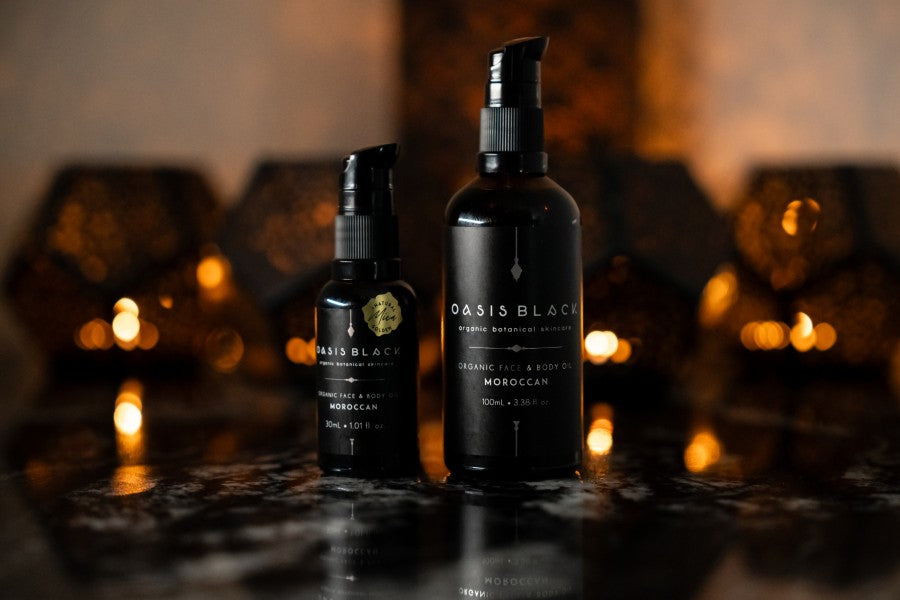To maintain healthy and youthful looking skin, we need to be feeding our skin with the most nutrient dense food it knows. For the most part, our skin knows how to utilise, loves and needs topical fats/oils/lipids for optimal health (not synthetics or water-based products - learn why here).
The most highly nutritious oils that offer the most bio-available compounds to our skin are non-comedogenic plant oils that have been Organically farmed and Minimally Processed.

MINIMALLY PROCESSED oils are ones that are as close as possible to their host plant material, with minimal interference and processing from humans. Minimally Processed Essential Oils are extracted using steam (aka Steam Distilled). And Minimally Processed Carrier Oils are obtained by simply squashing/pressing plant matter at cool temperatures (aka Cold Pressed), then lightly filtering the oil to remove sediment/solids.
As a result, Minimally Processed oils are naturally abundant in fat-soluble vitamins (A, D, E & K), minerals, essential fatty acids, antioxidants, polyphenols, carotenoids and phytosterols as well as a variety of other beneficial compounds like squalene and CoQ10. So there’s simply no need to add in any inferior synthetics.
Whereas, more common industrial oil processing techniques like heat extraction, solvent extraction, heavy refining, deodorising, bleaching and de-gumming are unnecessarily wasteful (they consume a lot of time, labour & monetary resources) and destructive as they contaminate, strip away and destroy the most beneficial components of the natural raw materials. The result is an oil with a long shelf life... but the cost is nutrient density, wasted resources and/or contamination. Oils treated with these processes are what the health/wellness industry generally refers to as "Seed Oils".
I'll take nutrient dense, cold pressed oils with a shorter shelf life over nutrient poor, contaminated and wasteful oils with a long shelf life any day
However, as my analysis shows, finding a suitable product isn't easy. Of the more than 160 products I analysed, it was staggering to see that less than 4% of products are 100% Organic, less than 25% could be considered All Natural, and less than 2% can claim that all carrier oils utilised are cold pressed.

And the more expensive the product, the worse these numbers are... particularly the increase in use of synthetics like toxic artificial fragrances and nutrient poor cheap filler (Petroleum and Coconut Oil) ingredients:

This is a really bad result! No wonder so many people have such bad reactions and experiences with other brands face &/or body oils.
And this is exactly why I started Oasis Black in the first place – there was not, and still isn’t, a single other product on the market that is 100% Organic, 100% Natural and all Carrier Oils utilised are Cold Pressed.

But if my Organic Face & Body Oils aren't for you, then the only way to be sure the products you're using don't masque the inclusions of toxic pesticide/fertiliser/solvent residues, synthetics, or nutrient poor cheap filler ingredients, is to always check the FULL INGREDIENT LIST yourself and look for products that are:
- 100% Natural
- 100% Organic
- Comprised of 100% plant oils
- All Carrier Oils are Cold Pressed
- All Essential Oils are Steam Distilled
- Free from vitamin and other synthetic compound additions
- Free from comedogenic oils (like Mineral Oil, Coconut Oil, Soyabean Oil, Olive Oil and others)
- Composed of a decent variety of plant oils to ensure maximum nutrition (just like your body needs more than 1 food for optimal health, so does your skin)
A good rule of thumb you can adopt is that if a company doesn’t say their ingredients are 100% natural, organic, cold pressed or steam distilled then it’s safe for you to assume they’re not.
Other Trends From My Analysis
~ PRICE ~
From the products I analysed, the average price/ml is $2.82/ml. You can also see from the charts above that higher prices don't indicate superior products/ingredients... the top 12 most expensive products have higher percentages of synthetics, toxic artificial fragrances and nutrient poor cheap filler ingredients. This suggests that the higher prices you’re paying for these products aren’t a reflection of the quality of the ingredients they use... rather I'd say it's a reflection of how much they spend on marketing.
Given the superior quality of the ingredients I use, it’s hard to imagine that I can keep my Organic Face & Body Oils price well below this average. Though I can achieve this because my operation is small, allowing me to focus on quality over quantity, and I choose not to pay big tech giants advertising fees so I don't need to pass these costs on to you.
With the value my products offer I believe my prices are accessible and more than fair, and my analysis proves this. Yet people consistently ask or expect discounts from me... Yes I could do as others do and artificially inflate my prices simply to satisfy peoples seemingly insatiable need for continuous discounts. But I see this as a deceptive and manipulative tactic – words I hope to never be associated with. Instead, I choose to price my products fairly (so I can earn a reasonable living from this work) and trust that my customers can recognise the immense value in my products without feeling the need to devalue my efforts by demanding discounts.
You’ll pay only $2/ml for a 30ml bottle of my Organic Face & Body Oils.
If you purchase a 100ml bottle, or REFILL your bottle at one of my stockists, you'll pay just $1.20/ml.
~ PACKAGING ~
Not only do “plastic products leach chemicals triggering toxicity” 32, but plastic that accidentally (or intentionally) ends up in the natural environment injures and kills wildlife. So it was pleasing to see the number of products moving away from harmful plastic packaging.
Less than 10% of the products I analysed are packaged in Plastic bottles.
Whilst there are there are several brands offering refill options for their products, there are no other brands offering in-store refills of their products (you can find a list of my stockists offering refills here).

Whilst offering refills has well placed intentions, all the refills I came across in my analysis were packaged in single use soft plastic pouches. From my research, there are no bio-degradable soft plastic pouches available on the market that are suitable to house oils. Furthermore, soft plastics are difficult to recycle (as evidenced by the collapse of REDCycle here in Australia), and are more likely to end up in landfill or polluting the natural environment.
Don't get me wrong, I dislike and avoid plastic packaging as much as possible (and I'm continuously looking for plastic free alternatives to my serum pump caps - so far Vivomer developed by Shellworks has me most hopeful), but if I was forced to choose between soft and hard plastic packaging, I’d choose hard plastic because at least it has a higher chance of being recycled.
~ PLANT OILS USED ~
It was interesting to note that the most common plant oils used in the products in my analysis are Jojoba Oil, Sunflower Oil and Rosehip Oil. Given its price point, I was surprised to see Rosehip Oil in the top 3 plant oils used in product formulations.

Conversely, the plant oils used least across the products I analysed are Blueberry Seed Oil, Hazelnut Oil and Nigella (Black) Seed Oil. I’m not surprised to see Blueberry Seed Oil as one of the least used oils because next to Red Raspberry Seed Oil it’s the most expensive Carrier Oil I use in my formula. Its price hasn't deterred me from including it in my Oils because it’s one of the most potent anti-aging carrier oils around.
Likewise, Hazelnut Oil is another under-rated carrier oil in my opinion. Including Hazelnut Oil in my formula was essential because of its superior skin tightening, pore minimising and sebum regulating abilities.
When I first started Oasis Black there was virtually no-one else using Black Seed Oil in their skincare formulas. So it's great to see that more people are now aware of it's amazing benefits (learn more about Black Seeds here), particularly for the skin.
~ OTHER ~
Full ingredient list availability was another issue for me. There are many companies in my analysis that make their full ingredient list (INCI preferably) difficult to find. Instead, I noticed a trend of making their 'key ingredient list' prominent, and hiding their full ingredient list elsewhere.
I find this deceptive as it indicates to me that they’ve got something to hide. Some didn’t even display their full ingredient list on their website at all and I had to contact them to obtain it. The biggest culprits were the more expensive “top end” products that only seem to be available through the big department stores and other retailers. Maybe those companies, retailers and department stores are forgetting that it’s illegal not to publish the full ingredient list of a product at the point of sale in Australia 33 (ie on their website when selling online)?
And finally, I couldn’t count the number of times I said “yuck” to myself whilst going through the ingredient lists of the products in my analysis. If it wasn’t the mainly synthetic formulas, then it was the formulas laden with toxic fragrances or nutrient poor, comedogenic and cheap filler ingredients (petroleum or coconut based) that had me screwing up my nose.
So please, please, please make sure you always seek out and read the FULL INGREDIENT LIST yourself, and educate yourself on any ingredients you’re unsure of, before purchasing any product.

The information on this blog constitutes the opinions of the author and is for information purposes only. It is not personal product or medical advice. Please always do your own product and medical research before using a product or following advice.
Sources
1A. Pravst I, Zmitek K, Zmitek J. Coenzyme Q10 contents in foods and fortification strategies. Crit Rev Food Sci Nutr. 2010 Apr;50(4):269-80. doi: 10.1080/10408390902773037. PMID: 20301015. https://pubmed.ncbi.nlm.nih.gov/20301015/
1B. López LC, Cabrera-Vique C, Venegas C, García-Corzo L, Luna-Sánchez M, Acuña-Castroviejo D, Escames G. Argan oil-contained antioxidants for human mitochondria. Nat Prod Commun. 2013 Jan;8(1):47-50. PMID: 23472457. https://pubmed.ncbi.nlm.nih.gov/23472457/
1C. Aissa R, Asbbane A, Oubannin S, Bijla L, Bousaid Z, Hallouch O, El Harkaoui S, Matthäus B, Sakar EH, Gharby S. Oxidative Stability of Virgin and Refined Argan [Argania spinosa L. (Skeels)] Oil under Accelerated Aging Conditions and Shelf-Life Prediction at Room Temperature: A Comparative Study. Analytica. 2023; 4(4):500-512. https://doi.org/10.3390/analytica4040034
1D. Tao Zheng, Min Tian, Zhuang Deng, Qi Tang, Zhubing Hu, Guodong Wang, Haitao Zeng, UPLC-MS/MS reveals the differences in lipids composition of Camellia oleifera from northern margin distribution area, Food Chemistry: X, Volume 23, 2024, 101629, ISSN 2590-1575, https://doi.org/10.1016/j.fochx.2024.101629
1E. Podar AS, Semeniuc CA, Ionescu SR, Socaciu MI, Fogarasi M, Fărcaș AC, Vodnar DC, Socaci SA. An Overview of Analytical Methods for Quantitative Determination of Coenzyme Q10 in Foods. Metabolites. 2023 Feb 14;13(2):272. doi: 10.3390/metabo13020272. PMID: 36837891; PMCID: PMC9964353. https://pmc.ncbi.nlm.nih.gov/articles/PMC9964353/
2. Lykstad J, Sharma S. Biochemistry, Water Soluble Vitamins. 2023 Mar 6. In: StatPearls [Internet]. Treasure Island (FL): StatPearls Publishing; 2025 Jan–. PMID: 30860745. https://www.ncbi.nlm.nih.gov/books/NBK538510/
3. Barry S. What Form of Vitamin Supplements Offers the Best Absorption? Healthline.com, April 2024. https://www.healthline.com/health/best-form-of-vitamins-for-absorption
4. Rudzińska M, Górnaś P, Raczyk M, Soliven A. Sterols and squalene in apricot (Prunus armeniaca L.) kernel oils: the variety as a key factor. Nat Prod Res. 2017 Jan;31(1):84-88. https://doi.org/10.1080/14786419.2015.1135146. Epub 2016 Jan 8. PMID: 26745662.
5. Persea Gratissima (Avocado) Oil: Skincare Benefits and Uses. Creamscan.com. https://creamscan.com/ingredients/persea-gratissima-oil/
6. Flores M, Saravia C, Vergara CE, Avila F, Valdés H, Ortiz-Viedma J. Avocado Oil: Characteristics, Properties, and Applications. Molecules. 2019 Jun 10;24(11):2172. doi: 10.3390/molecules24112172. PMID: 31185591; PMCID: PMC6600360. https://pmc.ncbi.nlm.nih.gov/articles/PMC6600360/
7. Gharby S, Charrouf Z. Argan Oil: Chemical Composition, Extraction Process, and Quality Control. Front Nutr. 2022 Feb 3;8:804587. doi: 10.3389/fnut.2021.804587. PMID: 35187023; PMCID: PMC8850956. https://www.frontiersin.org/journals/nutrition/articles/10.3389/fnut.2021.804587/full
8. Verhe R. BERRY SEEDS: A SOURCE OF SPECIALTY OILS WITH HIGH CONTENT OF BIOACTIVES AND NUTRITIONAL VALUE. Journal of Food Lipids. 2009; doi:10.1111/J.1745-4522.2009.01130.X. https://doi.org/10.1111/J.1745-4522.2009.01130.X
9. Yu J, Yan H, Wu Y, Wang Y, Xia P. Quality Evaluation of the Oil of Camellia spp. Foods. 2022 Jul 26;11(15):2221. doi: 10.3390/foods11152221. PMID: 35892806; PMCID: PMC9368027. https://pmc.ncbi.nlm.nih.gov/articles/PMC9368027/
10. Camellia Seed Oil: A Beauty Elixir From East Asia. New Direction Aromatics, blog. https://www.newdirectionsaromatics.com/blog/camellia-seed-oil-a-beauty-elixir-from-east-asia/
11. H. Xiao, Z. Yao, Q. Peng, F. Ni, Y. Sun, C.X. Zhang, Z.X. Zhong, Extraction of squalene from camellia oil by silver ion complexation, Separation and Purification Technology, Volume 169, 2016, Pages 196-201,ISSN 1383-5866, https://doi.org/10.1016/j.seppur.2016.05.041
12. Tian M, Bai Y, Tian H, Zhao X. The Chemical Composition and Health-Promoting Benefits of Vegetable Oils—A Review. Molecules. 2023; 28(17):6393. https://doi.org/10.3390/molecules28176393
13. Fernandes, Gabriel & Gómez-Coca, Raquel & Camino, M. & Moreda, Wenceslao & Arellano, Daniel. (2017). Chemical Characterization of Major and Minor Compounds of Nut Oils: Almond, Hazelnut, and Pecan Nut. Journal of Chemistry. 2017. 10.1155/2017/2609549. https://doi.org/10.1155/2017/2609549
14. Marina Contini, Maria Teresa Frangipane, Riccardo Massantini, Chapter 72 - Antioxidants in Hazelnuts (Corylus avellana L.), Editor(s): Victor R. Preedy, Ronald Ross Watson, Vinood B. Patel, Nuts and Seeds in Health and Disease Prevention, Academic Press, 2011, Pages 611-625, ISBN 9780123756886, https://doi.org/10.1016/B978-0-12-375688-6.10072-6. https://www.researchgate.net/publication/273958042_Antioxidants_in_Hazelnuts_Corylus_avellana_L
15. Shamama JAVED, Muhammad H. SULTAN, Waquar AHSAN, Asim NAJMI, Hassan A. ALHAZMI, Mohammed ALBRATTY, Osama MADKHALI, Yosif ALMOSHARI, Zia ur REHMAN, & Md Shamsher ALAM. Chemometrics-assisted Comparative Chemical Profiling of Marketed Nigella sativa L. Seed Oils Using Spectroscopic Techniques. Latin American Journal of Pharmacy. 41 (10):1917-29 (2022). http://www.latamjpharm.org/resumenes/41/10/LAJOP_41_10_1_3.pdf
16. Dąbrowski G, Czaplicki S, Konopka I. Variation in the Composition and Quality of Nigella sativa L. Seed Oils—The Underestimated Impact on Possible Health-Promoting Properties. Molecules. 2024; 29(6):1360. https://doi.org/10.3390/molecules29061360
17. Hamouda AF, Felemban S. Biochemical Pilot Study on Effects of Pomegranate Seed Oil Extract and Cosmetic Cream on Neurologically Mediated Skin Inflammation in Animals and Humans: A Comparative Observational Study. Molecules. 2023;28(2):903. Published 2023 Jan 16. doi:10.3390/molecules28020903. https://doi.org/10.3390/molecules28020903
18. Hamouda, Asmaa & Farawilla, Taymour-Lank & Attafi, Ibraheem & Khardali, Ibrahim & Attafi, Mohammad & Oraiby, Magbool & Abualsail, Farid. (2021). Screening Pilot Study of Fruit Seed Compositions by GC-MS and Their Potential Scenario Anti ACE2 and 2rh1 Receptors as a Recycling Possibility in the Coronavirus Pandemic. Journal of Clinical Medical Research. 02. 10.46889/JCMR.2021.2202. http://dx.doi.org/10.46889/JCMR.2021.2202
19. Grajzer M, Wiatrak B, Gębarowski T, et al. Bioactive Compounds of Raspberry Oil Emulsions Induced Oxidative Stress via Stimulating the Accumulation of Reactive Oxygen Species and NO in Cancer Cells. Oxid Med Cell Longev. 2021;2021:5561672. Published 2021 Jun 8. doi:10.1155/2021/5561672. https://doi.org/10.1155/2021/5561672
20. Zeeshan Ahmad, The uses and properties of almond oil, Complementary Therapies in Clinical Practice, Volume 16, Issue 1, 2010, Pages 10-12, ISSN 1744-3881, https://doi.org/10.1016/j.ctcp.2009.06.015.
21. Nergiz, Cevdet & Çelikkale, Deniz. (2011). The effect of consecutive steps of refining on squalene content of vegetable oils. Journal of Food Science and Technology. 48. 382-385. 10.1007/s13197-010-0190-2. http://dx.doi.org/10.1007/s13197-010-0190-2
22. Coco-Caprylate/Caprate Overview. Onosight. https://ontosight.ai/glossary/term/coco-caprylate-caprate-overview--67a20d81c445bf945aeb13f7
23. Zanolli L. Why smelling good could come with a cost to health. The Guardian, Toxic America: Fragrance, May 2019. https://www.theguardian.com/us-news/2019/may/23/fragrance-perfume-personal-cleaning-products-health-issues
24. Fragrance. Campaign for Safe Cosmetics. https://www.safecosmetics.org/chemicals/fragrance/
25. Gharby S. Refining Vegetable Oils: Chemical and Physical Refining. ScientificWorldJournal. 2022;2022:6627013. Published 2022 Jan 11. doi:10.1155/2022/6627013. https://doi.org/10.1155/2022/6627013
26. Bayala, Isso & Ryan, David. (2012). Extraction of α-tocopherolquinone from vegetable oil deodorizer distillate waste. European Journal of Lipid Science and Technology. 114. 10.1002/ejlt.201100380. https://doi.org/10.1002/ejlt.201100380
27. Petrolatum, Petroleum Jelly. Campaign for Safe Cosmetics. https://www.safecosmetics.org/chemicals/petrolatum/
27a. Sombiri, S., Balhara, N., Attri, D. et al. An overview on occurrence of polycyclic aromatic hydrocarbons in food chain with special emphasis on human health ailments. Discov Environment 2, 87 (2024). https://doi.org/10.1007/s44274-024-00121-6
28. Regulation (EC) No 1272/2008 of the European Parliament and of the Council of 16 December 2008 on classification, labelling and packaging of substances and mixtures, amending and repealing Directives 67/548/EEC and 1999/45/EC, and amending Regulation (EC) No 1907/2006 (Text with EEA relevance): https://eur-lex.europa.eu/eli/reg/2008/1272/2025-02-01/eng
29. Ghazani SM, Marangoni AG, Fractionated coconut oil and MCT oil production: facts and fiction. INFORM - International News on Fats. Volume 31 (9), 2020. https://www.researchgate.net/publication/344415781_Fractionated_coconut_oil_and_MCT_oil_production_facts_and_fiction
30. GW Burton, MG Traber, RV Acuff, DN Walters, H Kayden, L Hughes, KU Ingold, Human plasma and tissue alpha-tocopherol concentrations in response to supplementation with deuterated natural and synthetic vitamin E, The American Journal of Clinical Nutrition, Volume 67, Issue 4, 1998, Pages 669-684, ISSN 0002-9165, https://doi.org/10.1093/ajcn/67.4.669.
31. Onyema, C. T., and K. K. Ibe. 2016. “Effects of Refining Processes on the Physicochemical Properties of Some Selected Vegetable Oils”. Chemical Science International Journal 12 (4):1-7. https://doi.org/10.9734/ACSJ/2016/23290.
32. Zimmermann L, Bartosova Z, Braun K, Oehlmann J, Völker C, Wagner M. Plastic Products Leach Chemicals That Induce In Vitro Toxicity under Realistic Use Conditions. Environ Sci Technol. 2021;55(17):11814-11823. doi:10.1021/acs.est.1c01103. https://doi.org/10.1021/acs.est.1c01103
33. Cosmetics ingredients labelling mandatory standard. ACCC Product Safety. https://www.productsafety.gov.au/business/search-mandatory-standards/cosmetics-ingredients-labelling-mandatory-standard
34. Pullar JM, Carr AC, Vissers MCM. The Roles of Vitamin C in Skin Health. Nutrients. 2017;9(8):866. Published 2017 Aug 12. doi:10.3390/nu9080866 https://doi.org/10.3390/nu9080866




































































































